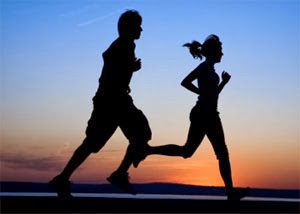2013 has seen lots of great performances from Eagle members but sadly several runners (myself included) -including some of the most experienced runners in the Club- have suffered protracted absences from competition because of running-related injuries over the last year. The risk of injury (and of injury recurrence) can be minimised by taking some precautionary steps.
I thought I would share with you an important study which recently appeared in the British Journal of Sports Medicine, one of the most prestigious publications in its field internationally.
The study was a systematic review and meta-analysis of randomised controlled trials – in layman’s terms the authors pooled the data from a number of previously validated and published trials using standard criteria. 25 trials, including 26,610 participants with 3,464 injuries, were analysed. In other words – a heck of a lot of data was pooled!
The authors compared the use of strength training alone, stretching alone , proprioception training alone and combinations of these strategies.
 The results were very interesting. Consistently favourable estimates were obtained for all injury prevention measures except for stretching. Strength training reduced sports injuries to less than one third and overuse injuries could be almost halved. This is highly impressive data based on studying large populations of sportsmen and women (rather than the habit or hearsay we too often rely on).
The results were very interesting. Consistently favourable estimates were obtained for all injury prevention measures except for stretching. Strength training reduced sports injuries to less than one third and overuse injuries could be almost halved. This is highly impressive data based on studying large populations of sportsmen and women (rather than the habit or hearsay we too often rely on).There was already a significant body of scientific opinion suggesting that stretching is of limited value.
What is strength training? Resistance training using weights, stretch bands or your own body weight can correct muscle imbalances and prevent injuries. Take advice from a qualified gym instructor if possible if you plan on starting a weights programme. Alternatively there is plenty of good information available in books (such as “Advanced Marathoning” by Pfitzinger & Douglas).
Certainly, vigorous stretching of muscles that are not well warmed up by gentle running for at least 15 minutes should be avoided as it increases the risk of injury. Dynamic stretching is probably better than the traditionally carried out passive/static stretching.
Many of us (myself included) find it hard to find the time or inclination to do weight training per se and prefer to spend that time running where possible. The good news is there is an alternative!
Hill running is a very useful form of resistance training. Your own body weight provides the resistance when running hills. There is evidence that running hills can produce improvements in running economy similar to those that occur through “normal” resistance training. You will simultaneously build your cardiovascular system.
The other good news is that there are plenty of hills in and around Cork- let’s get out and use them! Speak to one of the club mentors for advice on how to incorporate hills into your training.
Ronan Boland









